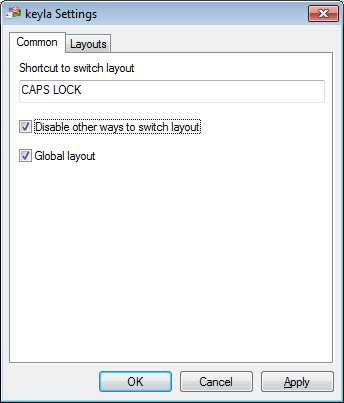There are two things that keep annoying me when I work, and I have just discovered that Keyla cleverly prevents both:
- Accidentally hitting cAPS LOCK AND TYPING EVERYTHING IN UPPERCASE, and
- Windows’ perpetual inability to remember what keyboard layout I want to use.
Here’s how Keyla helps to solve both of these problems. First, be aware that Keyla basically is a keyboard-layout switcher but it can be useful even when you only use one layout. This is because Keyla can grab the Caps-lock keypress and use it for its own purposes, thereby disabling that annoying Caps-lock. Even better, Keyla cleverly provides a way to still get Caps-lock if you really want it: pressing Shift+Caps turns it on and off.

If you use multiple keyboard layouts then you’ll have noticed that every version of Windows ever has an annoying “feature”: Windows doesn’t have a global layout setting. The chosen keyboard layout is specific for each running application. In practice, this is immensely annoying because you always end up with the wrong layout when you switch from one window to another.
Keyla to the rescue, again! As you can see from the screenshot above, the setting Global layout puts an end to this nonsense. Whatever layout is active, stays active in all windows until you choose another layout, which then becomes the new global layout. Finally!
As an added trick, Keyla can also prevent any other keyboard-switching shortcuts like Alt+Leftshift that would often confound me.

Hello, I think that it is very nice. Could we make our own code like that?
Hello – Keyla is nice but inflexible. I suggest that you google “AutoHotkey” (AHK) instead. It is a tool that lets you reassign any keyboard keystroke, or combination of keystrokes. It also offers many other clever tricks. The AHK syntax is not difficult to learn, but it does require a familiarity with computer code.